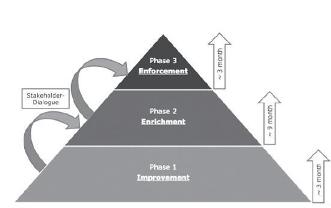Siemens - Channeling Innovation on the Intranetplatform Techno Web2.0
Sommersemester 2011
Executive Summary
On the basis of a deep analysis of strengths and pain points of the current management of the Fuzzy Front-End (FFE) of innovations at A1, this project provides a recommendation on how to optimize the structure of the FFE management for a more successful idea selection, evaluation and new product development.
Background, Problem, Goal:
“If Siemens only knew, what Siemens knows.” – Comprehensive knowledge management is one of the most challenging tasks in a multinational company like Siemens consisting of 405,000 employees dispersed globally and organized in numerous departments and subdivisions.
There is no doubt that an efficient tool to exploit these synergies would significantly support and facilitate innovative activities.
As early as 1998 an intranet platform called TechnoWeb was designed to do precisely that – facilitate networking and problem-solving. After the emergence of Web2.0 it was re-launched as TechnoWeb2.0. Very much like a company version of “Facebook”, this platform allows its 11,000 users to create profiles, set-up and participate in networks and finally contact experts via urgent requests.
When the project partner approached the Institute of Entrepreneurship and Innovation they had observed that while there were certain activities that already worked well on the platform there was little innovative activity taking place at the TechnoWeb. Consequently they were looking to lift this platform to the next level by putting in place an environment that would also foster innovation.
Thus a cross-functional team of three master and bachelor students was assembled in order to develop a specific concept to foster idea generation on “TechnoWeb2.0”.
Methodology
As a basis this team studied pertinent literature in order to identify general success factors of such platforms. With this knowledge an in-depth analysis of the actual platform, TechnoWeb2.0” was conducted in the course of which 22 semi-structured interviews with users were held. 5 major barriers to innovation were identified. With this knowledge in mind the team looked at other innovation initiatives, like Idea Contests and Innovation Jams, within Siemens to get a sense on how these challenges were tackled there. In a third step 5 interviews were conducted with software suppliers who provide companies with state-of-the art software solutions. Finally the team interviewed 7 companies using the offered software
solutions placing special emphasis on how the Siemens specific challenges were tackled.
Drawing from these four sources a threephased recommendation was designed which will enable Siemens to unleash the vast potential on TechnoWeb2.0.
Findings & Analysis
During the conversations with users, moderators, innovation managers, etc. the following five challenges were identified:
Lack of perceived benefit
Users often do not see a direct benefit of contributing to the platform.Lack of management support
Management has not yet put emphasis in communication that usage is desired.Internal competition for resources
A fierce internal marketplace often prevents co-operation and free-revealing.Trade-Off between openness and focus
The open nature of the platform hinders focused discussions to occur.Cultural setting
Siemens employees are often not used to engaging online using communication facilities such as posting and commenting.
Recommendation
After thorough analysis the following threephased approach was designed.
[Abb. vgl. unten]
In a first phase key functionalities like the search function of TechnoWeb2.0 will be improved. This is to immediately increase perceived benefit for all users. These improvements can be implemented for the entire “TechnoWeb2.0” community.
In a second phase certain innovation addons are introduced in order to tackle the challenges. These include:
Closed rooms and layers of confidence
The ability to create private communities and control the information available to the individual members.Structured Feedback
A more structured way to give and receive
feedback on ideas by including experts.Direct Communication tools
The ability to directly chat, call or have a video conference with the members of a network.Sponsors and Moderators
Management lending their name to certain networks to boost their legitimacy as well as appointed moderators to lead the discussions.Teaming function
Ability to better identify and contact experts of unrelated fields of expertise through TechnoWeb2.0
Users confronted with the concept, knowledge gained from literature research as well as the analysis of well-functioning platforms in other companies all indicate the necessity and importance of the above factors. The described add-ons will first be tested in a pilot phase open only to selected users. This way costs can be limited and the functionalities can be efficiently tailored to the user community.
In a final and third phase the improved and enriched platform is promoted. Through word-of-mouth recommendation a bandwagon effect will kick in, thus increasing participation, activity and eventually innovation on the platform.
In order to assure the highest possible degree of satisfaction of all stakeholders a continuous stakeholder dialogue will accompany the three phases.
Cooperation Partner
Siemens AG Österreich
Siemens Chief Technology Office
Open InnovationContact Person
Fabrizio De Pasquale
Tel: +43(0)5170722969
E-Mail: fabrizio.de-pasquale@siemens.com
Student Team
Fani Christofi
Johannes Greller
Selene Horner
Nino Mori
Isaac Newton Acqua
Pablo Piñero
![[Translate to English:]](/fileadmin/wu/_processed_/b/f/csm_104-Laptop-960_v1_8833b81630.jpg)
